三毛双语英语介绍
- 格式:ppt
- 大小:5.35 MB
- 文档页数:12
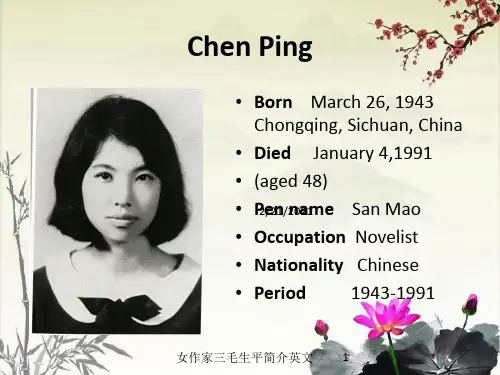


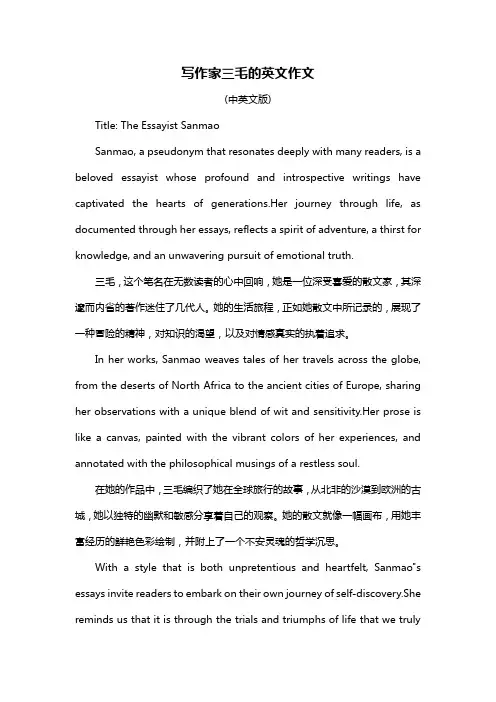
写作家三毛的英文作文(中英文版)Title: The Essayist SanmaoSanmao, a pseudonym that resonates deeply with many readers, is a beloved essayist whose profound and introspective writings have captivated the hearts of generations.Her journey through life, as documented through her essays, reflects a spirit of adventure, a thirst for knowledge, and an unwavering pursuit of emotional truth.三毛,这个笔名在无数读者的心中回响,她是一位深受喜爱的散文家,其深邃而内省的著作迷住了几代人。
她的生活旅程,正如她散文中所记录的,展现了一种冒险的精神,对知识的渴望,以及对情感真实的执着追求。
In her works, Sanmao weaves tales of her travels across the globe, from the deserts of North Africa to the ancient cities of Europe, sharing her observations with a unique blend of wit and sensitivity.Her prose is like a canvas, painted with the vibrant colors of her experiences, and annotated with the philosophical musings of a restless soul.在她的作品中,三毛编织了她在全球旅行的故事,从北非的沙漠到欧洲的古城,她以独特的幽默和敏感分享着自己的观察。

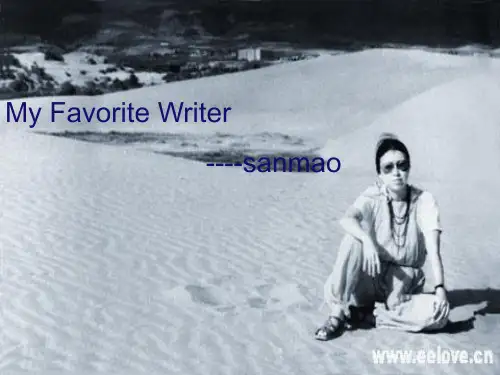
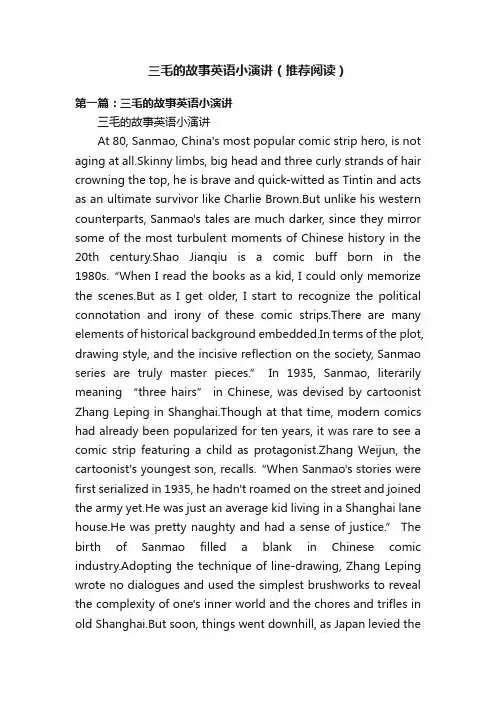
三毛的故事英语小演讲(推荐阅读)第一篇:三毛的故事英语小演讲三毛的故事英语小演讲At 80, Sanmao, China's most popular comic strip hero, is not aging at all.Skinny limbs, big head and three curly strands of hair crowning the top, he is brave and quick-witted as Tintin and acts as an ultimate survivor like Charlie Brown.But unlike his western counterparts, Sanmao's tales are much darker, since they mirror some of the most turbulent moments of Chinese history in the 20th century.Shao Jianqiu is a comic buff born in the 1980s.“When I read the books as a kid, I could only memorize the scenes.But as I get older, I start to recognize the political connotation and irony of these comic strips.There are many elements of historical background embedded.In terms of the plot, drawing style, and the incisive reflection on the society, Sanmao series are truly master pieces.” In 1935, Sanmao, literarily meaning “three hairs” in Chinese, was devised by cartoonist Zhang Leping in Shanghai.Though at that time, modern comics had already been popularized for ten years, it was rare to see a comic strip featuring a child as protagonist.Zhang Weijun, the cartoonist's youngest son, recalls.“When Sanmao's stories were first serialized in 1935, he hadn't roamed on the street and joined the army yet.He was just an average kid living in a Shanghai lane house.He was pretty naughty and had a sense of justice.” The birth of Sanmao filled a blank in Chinese comic industry.Adopting the technique of line-drawing, Zhang Leping wrote no dialogues and used the simplest brushworks to reveal the complexity of one's inner world and the chores and trifles in old Shanghai.But soon, things went downhill, as Japan levied thewar of aggression against China.Zhang and other cartoonists left home and travelled around the country to disseminate the message of resistance and patriotism.During his eight-year rove, the artist witnessed how bloodshed, violence and misery ravaged China.Heartbreakingly, he also watched ordinary people, particularly young children, become the victims of the war.Zhang Weijun says those experiences transformed his father's artworks drastically.“I think his wartime experience became his baptism and purified him.From then on, he was determined to see the world and reflect problems for the sake of common people.He came back to Shanghai in 1945.One year later, he drew the comic 'Sanmao Joins the Army', which combined the happenings he went through.Once published, the response was overwhelming.” In this blood-soaked cartoon story, the homeless Sanmao puts on ill-fitting uniform to fight against aggressive Japanese army.Despite his short height and gaunt feature, the boy is able to survive on the bullet-flying battleground and uses his size and wit as advantage to defeat much superior enemies.“Sanmao experiences a lot and his endeavors always end in vain.But he never gives up.No matter what happens, he carries on and moves on.” After the huge success of his first book, in 1947, Zhang Leping created another classic caricature of his: The Wonderings of Sanmao.This time, our beloved urchin lingers on the streets alone and hangs around with beggars, refugees and orphans in the post-war Shanghai.Constantly being beaten and mocked, he is starved while the rich feast and celebrate.Sanmao's bitter experience and hardship resonated with many of that time, which has gradually elaborated this character to national fame.After the establishment of People's Republic of China, Zhang produced a sequence of comic strips to illustrate Sanmao's new life, but theprevious two series remain the most popular ones.Dong Xiaoyan is the director of Zhang Leping museum, which commemorates the artist's contribution to Chinese cartoon industry and the eternal joy and inspiration his works bring.“S anmao grows up with generations of Chinese children.He is vivacious and tough.That's why we not only receive local visitors but also admit people all around China and the rest of the world.” For decades, filmmakers, musicians and animation producers have doted on this mischievous and good-natured boy.Even the famous Taiwanese writer Chen Maoping empathized with him and changed her pen name into “Sanmao”.Zhang Weijun, son of the cartoonist, explains the reason behind Sanmao's everlasting popularity.“The Sanm ao franchise, particular 'The Wonderings of Sanamo', is not just for children.The stories might better suit adult readers, since they reflect the fickleness and inconstancy of the society.Generally speaking, cartoon is an art of comedy and humor.There are no doubt humorous and funny elements in my father's books.But he illustrated them in a tragic way.I think compared with comedy, tragedy is much easier to strike a chord.” But as time goes by, is Sanmao's story still well-received among today's readers? As both a fierce lover for Sanmao series and curator of several Sanmao exhibitions, Shao Jianqiu gives a confirmative answer.“If an artwork is good enough in terms of its aesthetic value, it will never be out of date.People are equipped with a basic standard of aesthetics.When an artistic expression meets this standard, it will shake off the yoke of time.”80 years elapses, Sanmao is still a child hero Chinese readers worship and he will carry on moving people with his innocence and a heart of gold.第二篇:三毛的故事三毛的故事关于三毛三毛,原名陈懋平(mào)(后改名为陈平),汉族,浙江舟山人,1943年三月二十六日出生于重庆黄桷桠。
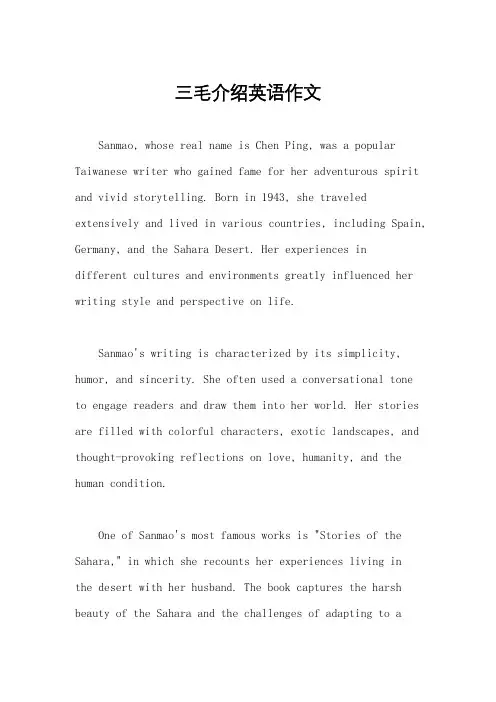
三毛介绍英语作文Sanmao, whose real name is Chen Ping, was a popular Taiwanese writer who gained fame for her adventurous spirit and vivid storytelling. Born in 1943, she traveled extensively and lived in various countries, including Spain, Germany, and the Sahara Desert. Her experiences indifferent cultures and environments greatly influenced her writing style and perspective on life.Sanmao's writing is characterized by its simplicity, humor, and sincerity. She often used a conversational toneto engage readers and draw them into her world. Her stories are filled with colorful characters, exotic landscapes, and thought-provoking reflections on love, humanity, and the human condition.One of Sanmao's most famous works is "Stories of the Sahara," in which she recounts her experiences living inthe desert with her husband. The book captures the harsh beauty of the Sahara and the challenges of adapting to anew way of life. Through her writing, Sanmao conveys a deep respect for the desert and its people, as well as a profound sense of wonder and awe.In addition to her travel writing, Sanmao also wrote essays, poetry, and children's literature. Her work has been translated into multiple languages and continues to inspire readers around the world. Despite her untimely death in 1991, Sanmao's legacy lives on through her timeless stories and the impact she made on literature and culture.。



写作家三毛的英文作文Sanmao: The Adventurous Spirit and Poetic Soul of a Remarkable WriterSanmao, whose real name was Chen Ping-wen, was a Taiwanese writer who captivated readers worldwide with her evocative memoirs and travelogues. Born in 1943 in Chongqing, China, Sanmao's life was marked by a profound sense of wanderlust and a deep appreciation for the beauty of the natural world. Through her vivid and lyrical prose, she invited her readers to join her on a journey of self-discovery, exploring the remote corners of the globe and delving into the complexities of the human experience.Sanmao's literary career began in the 1970s, when she published her first collection of essays, "Stories of the Sahara." This work, which chronicled her time living in the Sahara Desert with her husband, José, quickly gained critical acclaim and established Sanmao as a distinctive and captivating voice in the world of travel writing. Her ability to seamlessly blend personal anecdotes, philosophical musings, and vivid descriptions of the natural landscape captivatedreaders, who were drawn into the mesmerizing world she had created.One of the hallmarks of Sanmao's writing was her keen eye for detail and her ability to convey the essence of a place through her words. In "Stories of the Sahara," she painted a vivid portrait of the Sahara, describing the vast, undulating dunes, the fierce sandstorms, and the resilient Tuareg people who called the desert home. Her descriptions were so evocative that readers could almost feel the scorching heat of the sun and the gritty texture of the sand beneath their feet.But Sanmao's writing was not merely a collection of travelogues; it was a reflection of her own personal journey of self-discovery. Throughout her works, she grappled with themes of love, loss, and the search for meaning in a world that often seemed indifferent to the struggles of the individual. Her memoir "The Wandering" chronicled her tumultuous relationship with José, who tragically drowned in a storm while they were living in the Sahara. The raw emotion and vulnerability she displayed in this work resonated deeply with readers, who found solace in her honest and unflinching exploration of grief and the human condition.Sanmao's writing was not only a means of self-expression but also a way for her to connect with the world around her. She was deeply fascinated by different cultures and customs, and her works oftenserved as a bridge between the East and the West. In "Stories of the Sahara," for example, she delved into the rich cultural traditions of the Tuareg people, introducing her readers to their intricate jewelry, their nomadic way of life, and their unique language.But Sanmao's impact extended far beyond her literary achievements. She was also a passionate advocate for environmental protection and social justice, using her platform to raise awareness about the pressing issues of her time. In her later years, she became involved in various charitable organizations, working to support the rights of women and children in developing countries.Sanmao's legacy as a writer and a humanitarian continues to inspire people around the world. Her works have been translated into numerous languages, and she has been the subject of numerous biographies and documentaries. In her native Taiwan, she is revered as a national treasure, and her image has become a symbol of the island's rich cultural heritage.But Sanmao's enduring appeal lies not only in her impressive body of work but also in the spirit that infused it. Throughout her life, she embodied a sense of adventure and a deep appreciation for the beauty of the natural world. Her writing was a testament to the power of the human spirit to overcome adversity and find joy in the simple pleasures of life.In a world that often prizes material wealth and social status, Sanmao's life and work serve as a reminder of the enduring value of curiosity, empathy, and a deep connection to the natural world. Her legacy continues to inspire readers and writers alike, reminding us of the transformative power of the written word and the importance of embracing the unknown with a sense of wonder and courage.。
The Wandering Life of San Mao: A Reflection on the Resilience of the Human SpiritIn the heart of China's bustling cities and vast countrysides, a figure stands out, a figure that has become synonymous with the struggles and dreams of the ordinary people—San Mao. His story, chronicled in the classic comic "The Wandering Life of San Mao," is not just a narrative of hardships and misfortunes; it's a testament to the resilience and indomitable spirit of the human heart.Born into poverty, San Mao's life is a constant struggle against hunger, cold, and loneliness. He roams the land, seeking work and a roof over his head, often finding himself at the mercy of harsh circumstances and unforgiving 命运. But despite the constant setbacks and challenges, San Mao never loses hope. His eyes remain bright with the promise of a better tomorrow, and his steps, though staggered, are never still.The comic, through its black-and-white illustrations and poignant dialogue, captures the essence of San Mao's character—his resilience, his kindness, and his unwavering belief in the power of human connection. In a world thatoften seems unkind and unforgiving, San Mao finds solace in the smallest of kindnesses—a meal shared with a stranger,a warm blanket in a cold night, or a simple handshake of solidarity.His journey is not just a physical one; it's an emotional odyssey that takes him through the valleys of despair and the peaks of hope. His interactions with other characters—whether it's a fellow traveler, a kind stranger, or a cruel taskmaster—reveal the complexities of human nature and the profound impact of empathy and compassion.What makes San Mao's story so compelling is its universality. His struggles are not unique to him; they are the struggles of millions who have faced poverty, hunger, and displacement. His triumphs, though small, are triumphs for all who believe in the power of perseverance and the promise of a better future.In the end, San Mao's wandering life is not just astory about survival; it's a celebration of the human spirit—the spirit that never gives up, the spirit that believes in the goodness of humanity, and the spirit that keeps us going even when the world seems against us. As SanMao strides into the horizon, his background a blend of sunshine and shadow, we are reminded that no matter how tough the journey, the human spirit will always find a wayto shine.**三毛流浪记:人类精神的韧性反思**在中国繁华的城市和广阔的乡村中,有一个身影脱颖而出,他与普通人的挣扎和梦想息息相关——他就是三毛。
三毛介绍英语作文When it comes to English essay writing, many students mayfeel overwhelmed by the task. However, with a structured approach and a clear understanding of the components thatmake up a good essay, the process can be much more manageable. Here's a guide to English essay writing inspired by the free-spirited and thoughtful insights of Sanmao, the renowned Chinese writer.Understanding the Essay Structure1. Thesis Statement: This is the core idea of your essay.It's like the heart of a tree, giving life to the entire composition. Be clear and concise, just as Sanmao's proseoften was.2. Introduction: This is where you hook your reader. Startwith an interesting fact, a question, or a quote that relates to your thesis. It's like the first step on a journey thatyou're inviting your reader to take with you.3. Body Paragraphs: Each paragraph should focus on one main idea that supports your thesis. Use evidence from your research—quotes, statistics, examples—to back up your points. Sanmao's detailed observations of life can be a great example of how to provide rich, supporting details.4. Conclusion: Summarize your main points and restate yourthesis in a new way. End with a final thought that leaves a lasting impression on your reader, much like the poignant endings of Sanmao's stories.Developing Your Writing Skills1. Vocabulary: Expand your vocabulary to express your ideas more precisely. Sanmao's work is filled with vivid and expressive language that can inspire you to find the right words for your essay.2. Grammar: A strong command of grammar is essential. Errors can distract from your message. Practice and review to ensure your sentences are grammatically correct.3. Coherence and Cohesion: Ensure your essay flows logically from one point to the next. Use transitional phrases to guide your reader through your argument.4. Editing and Proofreading: Never underestimate the power of revision. Sanmao was known to revise her work multiple times to achieve clarity and impact. Read your essay aloud to catch awkward phrasings and typos.Finding Your VoiceSanmao's writing is characterized by its authenticity and emotional depth. As you write your essay, strive to find a voice that is true to you. Be honest and genuine in expressing your thoughts and ideas.Tips for Success1. Plan Ahead: Before you start writing, outline your essay. Knowing where you're going can make the writing process smoother.2. Read Widely: The more you read, the better you'll understand how to construct sentences and develop arguments.3. Practice Regularly: Writing is a skill that improves with practice. Write essays on different topics to become more versatile.4. Seek Feedback: Have peers or teachers review your work. Constructive criticism can be invaluable for improvement.5. Stay Inspired: Read Sanmao's works for inspiration. Her unique perspective and storytelling can motivate you to think creatively.By embracing the structure and developing your skills, you can write an English essay that is not only academically sound but also a reflection of your unique voice and perspective. Remember, writing is an art, and like Sanmao, you too can craft essays that are both informative and engaging.。
Echoes of San Mao in English EssaysEchoing through the corridors of time, the name of San Mao resonates with a unique melody, a harmony of adventure, romance, and a profound understanding of life. Her works, both in Chinese and English, have captivated readers across the globe, painting vivid portraits of her journey through life, love, and the pursuit of happiness.San Mao, a Chinese writer and traveler, was renownedfor her candid and heartfelt writing style. Her English essays, often written during her travels abroad, offer a glimpse into her thoughts and feelings as she navigated through foreign cultures and landscapes. These essays are not just accounts of her adventures; they are also reflections on human nature, relationships, and the complexities of existence.One of the most striking aspects of San Mao's English essays is her ability to capture the essence of a place or an experience with just a few words. She weaves together vivid descriptions of landscapes, people, and customs, creating a visual and emotional tapestry that transports the reader to another world. Her use of language is bothpoetic and profound, revealing a deep understanding of the world and its inhabitants.Moreover, San Mao's essays are filled with insights on love and relationships. She writes candidly about her own experiences, sharing both the joys and the pains of being in love. Her essays explore the nuances of emotional connections, the challenges of maintaining relationships, and the transformative power of love.Beyond the personal, San Mao's essays also delve into broader themes of life and existence. She reflects on the meaning of life, the pursuit of happiness, and the challenges faced by individuals in a world that is often unpredictable and unfair. Her thoughts are both profound and Insightful, offering readers a new perspective on life and its complexities.The popularity of San Mao's English essays can be attributed to their accessibility and relatability. Her writing style is direct and honest, making it easy for readers to connect with her thoughts and feelings. Her essays are not just for Chinese readers; they speak to auniversal audience, resonating with people across cultures and backgrounds.In conclusion, San Mao's English essays are a testament to her writing prowess and her unique understanding of life. They offer readers a window into her world, a world that is both familiar and exotic, filled with adventure, romance, and profound insights on life and love. As we continue to explore and understand the world, San Mao's essays remain a valuable resource, providing us with insights andinspiration that are as relevant today as they were whenshe first penned them.**三毛英语作文的回响**时光的长廊中,三毛的名字以其独特的旋律回荡着,那是冒险、浪漫和对生活的深刻理解的和谐之声。
写三毛的作文英文下载温馨提示:该文档是我店铺精心编制而成,希望大家下载以后,能够帮助大家解决实际的问题。
文档下载后可定制随意修改,请根据实际需要进行相应的调整和使用,谢谢!并且,本店铺为大家提供各种各样类型的实用资料,如教育随笔、日记赏析、句子摘抄、古诗大全、经典美文、话题作文、工作总结、词语解析、文案摘录、其他资料等等,如想了解不同资料格式和写法,敬请关注!Download tips: This document is carefully compiled by theeditor. I hope that after you download them,they can help yousolve practical problems. The document can be customized andmodified after downloading,please adjust and use it according toactual needs, thank you!In addition, our shop provides you with various types ofpractical materials,such as educational essays, diaryappreciation,sentence excerpts,ancient poems,classic articles,topic composition,work summary,word parsing,copyexcerpts,other materials and so on,want to know different data formats andwriting methods,please pay attention!Three hairs left on the pillow, a note on the bedside table. She's gone again, off to chase the wind and dancewith the waves. The scent of her perfume lingers in the air, a reminder of her free spirit and untamed heart.The sun sets over the horizon, painting the sky in shades of pink and orange. She used to say that each sunset was a promise of a new beginning, a chance to start overand embrace the unknown. I wonder where she is now, what adventures she's embarked on, and if she's thinking of meas much as I think of her.Her laughter echoes in my mind, a melody that soothesmy restless soul. She was a storyteller, spinning tales of faraway lands and mythical creatures. I was her captive audience, hanging on to every word, lost in the magic ofher imagination.I trace the outline of her face in the photograph onthe nightstand, memorizing every curve and line. She was a mystery, a puzzle I could never solve. But maybe that was the beauty of her – always keeping me on my toes, never letting me get too comfortable.She was a wanderer, a nomad at heart. The world was her playground, and she played by her own rules. I was just a bystander, watching as she danced through life with grace and determination. And though she's gone, I know she'll always be a part of me, a whisper in the wind, a memory etched in my heart.。